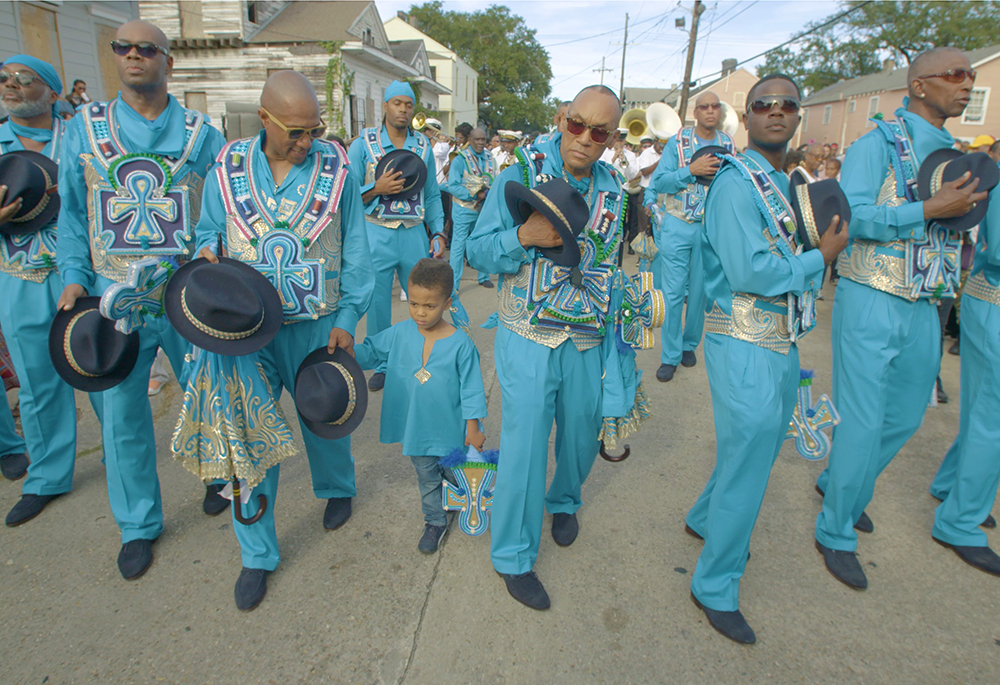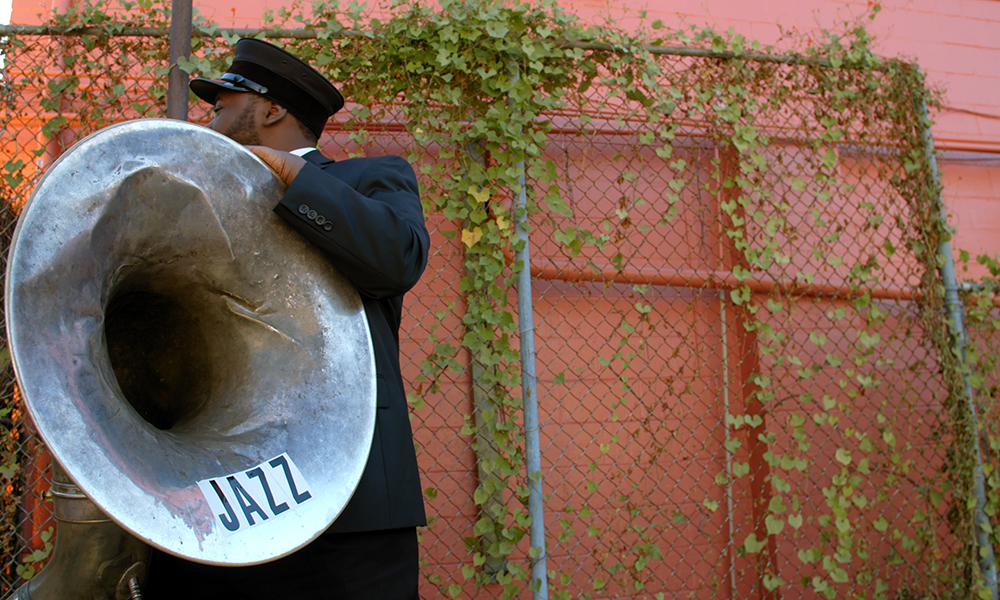
The group Black Men of Labor is seen marching and singing "Amazing Grace" during their annual second line parade in the documentary "City of a Million Dreams." (Courtesy of Spirit Tide Productions)
To tell a story of New Orleans requires a certain patience and reserve. A willingness to draw connections that are hardly possible for any other city in America, yet undeniable in the Big Easy. Most of all, telling a New Orleans story means telling a Black story.
A Black Catholic one, I might add.
Jason Berry's 2021 documentary "City of a Million Dreams" is such a tale, taking viewers through the contours of the northernmost Caribbean city by way of its greatest hallmark: jazz music. Specifically, the film describes how the tradition of jazz funerals emerged from the confluence of West Africa and Franco-Spanish colonialism, in an era when excessive death was an ever-present reality.
The film begins with a prayer service led by a Black Catholic priest in an open field, embodying a theme that runs throughout the film, a 90-minute-long adventure into what makes New Orleans go. Though the various Catholic churches, liturgies and scenes are not always stated to be so, it is clear that there is something peculiar about the American home of Mardi Gras.
Most reveler-tourists know the city for that particular feast, which features rollicking displays of libertine joy, but few are aware that Fat Tuesday is more or less part of a year-round tradition. Through interviews with historians, musicians, journalists and culture bearers, Berry's film shows how the very idea of Black Creole song and dance informs the ethos of the city from life to death.
Several jazz funerals are depicted in the film, including the legendary early jazz stalwart Papa John Joseph, second-generation stars Danny Barker and Louis Barbarin, civil rights lawyer Lolis Elie Sr. and blues songstress "Lady Linda" Young Lacen. All but the last were Black Catholics.
In Lacen's case, the scene included a full-on jam session in the funeral parlor, a truly remarkable sight. More striking still was a similar display inside of a Catholic church — St. Augustine's, one of the oldest Black parishes in America — during or after the funeral Mass for Big Chief Donald Harrison Sr., a leader in the Mardi Gras Indian community.
The film wastes no time exploring what can ultimately be described as the theology behind the jazz funeral tradition, borne from the spiritual traditions of the enslaved. Their unhesitant connection of the earth below with the unseen realm is said to have informed their belief that to give exuberant artistic and cultural displays at one's death is part and parcel to the prayer offered for their safe repose.

A tuba player prepares to play a jazz funeral in New Orleans in Jason Berry's documentary "City of a Million Dreams." (Courtesy of Spirit Tide Productions)
In "the most African city in America," as one of the film's interviewees calls New Orleans, there is an unbreakable liturgical bond between the joy of life and the pain of passing, whether you knew the deceased or not. The second line parades, which in the film are seen stretching for miles with hundreds or even thousands of participants, shut down entire neighborhoods and attract passersby and onlookers into the flow, while others dance atop a nearby roof as the dead are "cut loose" to the next life.
"When you go to a funeral, that's the last thing you can do for that person," says Fred Johnson Jr., co-founder of Black Men of Labor, a local benevolent society in New Orleans that helps organize Black funerals and the accompanying second line parades, and works to preserve traditional jazz music and culture. (The Catholic overtones in his words are striking, but the film takes a more subdued tone, preferring to show rather than tell.)
In "the most African city in America," as one of the film's interviewees calls New Orleans, there is an unbreakable liturgical bond between the joy of life and the pain of passing.
Weaving its thread through the more than 300 years of colonial and post-colonial history in the region, the film does not shy away from the stories of Black struggle, including both resistance and tragedy. From yellow fever to Hurricane Katrina, the intersecting stories of loss help inform the film's apparent thesis that nothing — not even death — can quite conquer the spirit of New Orleans. Indeed, an acute sense of mortality and the hereafter may very well be its guiding force.
Even so, like many aspects of New Orleans culture, the jazz funeral tradition has at times been marred with violence, such that some figures of note preferred to be buried with quiet reserve instead, so as to avoid a bloody scene.
Advertisement
Unfortunately, this phenomenon has never quite been overcome, with a major arc of the film being the demise of one of its primary interlocutors, Deborah "Big Red" Cotton, a victim of a mass shooting at a Mother's Day parade in 2013. She survived the incident, but succumbed to her injuries four years later, before the film was completed. This perhaps underscores the fact that the film is not just an interesting tale to be told, but a very real, concrete story reaching even into the present day — good, bad and ugly.
In the end, death, as it were, is both the animator and the antagonist of the film. Some die old and others die young, as anywhere in the world, but in New Orleans they are often met with a certain celebration that cannot be easily explained.
Somehow, though, Berry manages to do exactly that, eschewing Hollywood's flashier trappings for a compelling story with its own undeniable effervescence. Who would think that a story largely about death could give such life? Then again, I guess that's just New Orleans for you.






